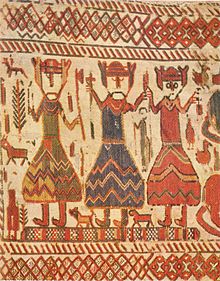Trifunctional hypothesis: Difference between revisions
→Further reading: Added references |
|||
| Line 37: | Line 37: | ||
== Further reading == |
== Further reading == |
||
* |
*Lincoln, Bruce. Theorizing Myth: Narrative, Ideology, and Scholarship (2000) |
||
*Littleton, C. S. ''The New Comparative Mythology''. 3rd ed. Berkeley 1982. |
|||
*Puhvel, Jaan. ''Comparative Mythology.'' Baltimore 1987. |
|||
==See also== |
==See also== |
||
Revision as of 06:59, 16 May 2007

The Trifunctional Hypothesis is a controversial conjecture proposed by French mythographer Georges Dumézil. The hypothesis states that Indo-European religion has societies and religions divided into three similar roles: warriors, priests, and farmers.
Three Way Division
Dumézil divided the Proto-Indo-European idea of sovereignty into two distinct and complementary parts. One part was formal, juridical, and priestly, but rooted in this world. The other powerful, unpredictable, and also priestly, but rooted in the other, the supernatural and spiritual world. Finally, there was a third group, who were ruled by the other two, whose role was productivity: herding, farming, and crafts.
The heart of the hypothesis is that both the society and the mythology are so divided. Each social group has its own god or family of gods to represent it, and that the function of both the group in its society and the function of the god or gods in the pantheon match. A recent alternate name for the hypothesis is function theory (but do not confuse sociological function theory with the completely separate mathematical subject with the same name).
Historical Examples
Dumézil believed that this tripartite division resulted in the arrangement of
- Brahmin, Kshatriya, and commoner castes in India
- Kings, Priests, and peasants in Europe
Dumézil argued that this dual sovereignty was expressed by pairs of gods such as
- Mitra and Varuna in Vedic India
- Dius Fidius and Jupiter Summanus in Rome
- Tyr and Odin in Norse mythology in Scandinavia
Medieval feudal society (an historic example not noted by Dumézil) was divided into:
- Oratores (those who pray), Bellatores (those who fight) and Laboratores (the workers)
Alternatively the roles can be represented by quasi-historical hero-figures, such as
They can also be represented by distinct religious confraternities, such as the
Critics of the tripartite system point out that there is no evidence that persons in these societies recognized an explicitly three-way division either of their gods or of their society, and that when there is written or mythological evidence, the caste or pantheon division is usually not three-way. For example the Norse gods were explicitly divided into two groups, the Aesir and the Vanir, not three. But the Indian and the Persian systems are three-way in the earliest texts. If the critics were correct, however, then the trifunctional hypothesis would be an example of a selection effect.
History of Controversy
The Trifunctional Hypothesis was published first in 1929 Georges Dumézil's book Flamen-Brahman, and was repeated later in Mitra-Varuna.[2] It was immediately controversial.
Dumézil's trifunctional hypothesis has received a great deal of criticism, both before and since his death in 1986. Some commentators consider it as much a form of mythology as the myths which he studied. Others point out that the tripartite division may be more of an artifact of Dumézil's own way of understanding mythologies and societies rather than an organizing principle used in the societies themselves.
References
- ^ Leiren, Terje I. (1999). From Pagan to Christian: The Story in the 12th-Century Tapestry of the Skog Church. Published online: http://faculty.washington.edu/leiren/vikings2.html
- ^ According to Jean Boissel, the first description of Indo-European trifunctionalism was by Gobineau, not by Dumézil. Bruce Lincoln 1999:268. Theorizing Myth: Narrative, Ideology, and Scholarship
Further reading
- Lincoln, Bruce. Theorizing Myth: Narrative, Ideology, and Scholarship (2000)
- Littleton, C. S. The New Comparative Mythology. 3rd ed. Berkeley 1982.
- Puhvel, Jaan. Comparative Mythology. Baltimore 1987.
